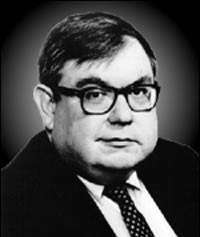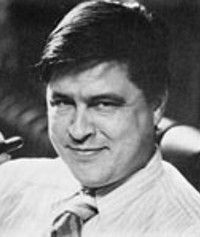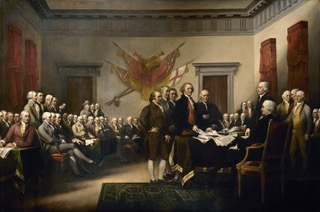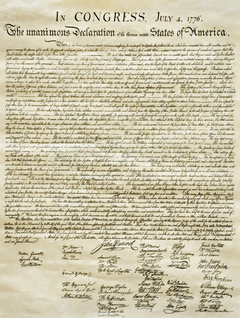 Samuel T. Francis
Samuel T. Francis
Championing
Western Civilization
and the great legacies of
Sam Francis and Joe Sobran
and their allies
 Joseph Sobran
Joseph Sobran
FGF Op-Ed
THE CONFEDERATE LAWYER
July 4, 2019

John Trumbull’s famous 1819 painting depicts the 5-man drafting committee of the Declaration of Independence presenting their work to the Continental Congress.
Happy Birthday, America!
by Charles G. Mills
Fitzgerald Griffin Foundation
Front Royal, Virginia — Independence Day, the Fourth of July, is America’s birthday. On July 4, 1776, the Continental Congress adopted the Declaration of Independence. On that day, thirteen British colonies declared themselves an independent country.
John Adams, one of our country’s Founding Fathers and our second president, said of this great event, "I am apt to believe that it will be celebrated by succeeding generations as the great anniversary festival. It ought to be commemorated as the day of deliverance, by solemn acts of devotion to God Almighty. It ought to be solemnized with pomp and parade, with shows, games, sports, guns, bells, bonfires, and illuminations, from one end of this continent to the other, from this time forward for evermore."
The creation of a new country by declaration was a new idea, without a precedent. The British were fully prepared to treat it as treason. The American patriots were fully aware that they were putting their lives and everything they owned at risk.

A tattered United States flag blows in the wind.
Independence Day, the Fourth of July, is America’s birthday. On July 4, 1776, the Continental Congress adopted the Declaration of Independence. On that day, thirteen British colonies declared themselves an independent country.
The document was not a list of rights like the Bill of Rights would be in 1789. It simply summarized them as “life, liberty, and the pursuit of happiness.” This summary is based upon the term in so many writings of the age “life, liberty, and property.” Some believe that “property” was left out to avoid the question of slavery.
Instead of attempting a list of all our rights, it listed the violations of certain rights by the British king.
Many of these were violations of the rights and customs of some or all of the colonies, such as frequently dissolving colonial assemblies, canceling colonial charters, holding sessions of assemblies in inconvenient places, and refusing to allow the election of new assemblies and the appointment of judges.
"I am apt to believe that [Independence Day] will be celebrated by succeeding generations as the great anniversary festival. It ought to be commemorated as the day of deliverance, by solemn acts of devotion to God Almighty. It ought to be solemnized with pomp and parade, with shows, games, sports, guns, bells, bonfires, and illuminations, from one end of this continent to the other, from this time forward for evermore." – John Adams, second President of America
Others were violations of English law, such as abolishing trials by jury in many cases, transporting Americans to England for trial, placing military law above civil law, and using “mock trials” to acquit British soldiers of murder.
Others were violations of more universal natural law, such as burning American towns, seizing Americans at sea and forcing them into the Royal Navy, inciting insurrections, causing the American Indians to engage in war against women and children, imposing taxes without representation, quartering soldiers in American homes, appointing many new and unnecessary officers to harass Americans and live off America's wealth, cutting off American trade, closing ports, preventing migration to America, and sending mercenary troops to America to commit crimes against the people of a type previously known only to barbarians.

The Declaration of Independence
The main draftsman of the document was Thomas Jefferson, probably a Deist, but it blended the thinking of Deists, Puritans, Anglicans, and a Catholic, all of whom shared a belief in natural law and of traditional English liberty.
This day, however, did not come in a vacuum or suddenly.
The creation of a new country by declaration was a new idea, without a precedent. The British were fully prepared to treat it as treason. The American patriots were fully aware that they were putting their lives and everything they owned at risk.
Englishmen, after a few unsuccessful attempts, founded a permanent colony in Virginia in 1607, and in Massachusetts in 1620. For about a hundred years the inhabitants of the English colonies thought of themselves as Englishmen, Scots, Welshmen, and Irish. In the early 1700s, they all began to think of themselves also as Britons. Indeed Georgia, the last of the colonies, was created as a British, not an English colony.
The Declaration of Independence was not a list of rights like the Bill of Rights would be in 1789. Instead it listed the violations of certain rights by the British king.
Americans began to think of themselves as American, not British. In 1753, the French in Canada invaded what is now Ohio. This led to the French and Indian War from 1754 to 1763. This left the Americans with a bad taste in their mouths from the British Army. Americans played a major role in our victory. George Washington won one of the major battles. The colonies sent large militias to war. Massachusetts alone sent eight regiments and two generals. The British Army, however, did not recognize the ranks of American generals, colonels and majors, treating them as mere captains. The conduct of the British soldiers was a scandal to the pious American militiamen.
Many of these were violations of the rights and customs of some or all of the colonies, such as frequently dissolving colonial assemblies and canceling colonial charters.
The British government wanted to keep its troops in America after the war but wanted the colonies to pay for them. In 1765 it passed the Stamp Act, which repudiated the long-established practice of having American taxes determined by colonial legislative bodies and replaced it by taxation by the British Parliament. The Stamp Act was so unenforceable in enough of America that it was repealed and replaced by laws giving a monopoly of the tea trade in America to the East India Company and taxing the importation of tea into America.
Others were violations of English law, such as abolishing trials by jury in many cases, transporting Americans to England for trial, placing military law above civil law, and using “mock trials” to acquit British soldiers of murder.
This led to a number of hostile acts on both sides. Some Bostonians threw a shipload of tea into the harbor and burned a ship. The British cancelled the Charter of Massachusetts, blockaded Massachusetts, and fired on and killed several people on the streets of Boston. The Americans convened a Continental Congress to provide some America-wide policy. At that time, it decided not to declare independence or to elect an American Parliament.
Others were violations of more universal natural law, such as burning American towns, seizing Americans at sea and forcing them into the Royal Navy, inciting insurrections, imposing taxes without representation, and quartering soldiers in American homes.
Open war broke out in 1775. By the summer of 1776 it was clear that America and Great Britain should go their separate ways. A Continental Congress was reconvened. Most of it favored independence, but America’s leaders wanted unanimity. With some difficulty it was achieved. There were a number of Americans who would remain loyal to Britain for the rest of their lives. Some went to Canada, some found a way to get along with an independent America.
The main draftsman of the document was Thomas Jefferson, probably a Deist, but it blended the thinking of Deists, Puritans, Anglicans, and a Catholic, all of whom shared a belief in natural law and of traditional English liberty.
There was probably a pro-British majority in Georgia, but Georgia decided to send the only Georgian who was familiar with the question of independence to the Continental Congress, thereby achieving unanimity of the states. In the end three Georgians signed the Declaration.
The war would continue until 1783, when Great Britain finally decided that the cost of continuing it was too great. It would take more than another five years for us to get a Constitution and Bill of Rights. It would take another war (1812-1815) with Britain before Great Britain decided to leave us alone.
On July 4, the Declaration of Independence, mostly the draftsmanship of Thomas Jefferson of Virginia, was signed. Virginia, New York, and New England provided most of the main spokesmen for independence. Charles Carroll of Maryland, the most prominent Catholic layman in America, signed, probably one of the reasons that religious liberty would grow so quickly after independence.
The Declaration of Independence was a revolutionary idea, but it was also a carefully written justification of American independence under both natural law and English Common Law.
The war would continue until 1783, when Great Britain finally decided that the cost of continuing it was too great. It would take more than another five years for us to get a Constitution and Bill of Rights. It would take another war (1812-1815) with Britain before Great Britain decided to leave us alone.
The Declaration of Independence was a revolutionary idea, but it was also a carefully written justification of American independence under both natural law and English Common Law. It is over 250 years old, but it has aged well and deserves careful study not only by all students but by all Americans as well.
###
Copyright @ 2024 by the Fitzgerald Griffin Foundation. All rights reserved. This article may be reprinted if credit is given to Charles G. Mills and fgfBooks.com.
Charles G. Mills, author of The Confederate Lawyer, is the Judge Advocate Emeritus (general counsel) for the New York State American Legion. As a New York lawyer, he has been arguing cases for fifty years in federal courts and in all levels of the New York courts.
The original of John Trumbull’s painting, “Declaration of Independence,” hangs in the United States Capitol rotunda. The true-to-life oil painting, which is pictured on the back of the $2 bill, measures 12 by 18 feet. Trumbull wished to include all 56 signers but painted just 42 as he was unable to find a likeness for 14 of them.
Help the Fitzgerald Griffin Foundation in its mission to publish the writings of Charles G. Mills and other great writers. Give a tax-deductible donation to FGF online.
Or send a check to: Fitzgerald Griffin Foundation344 Maple Avenue West, #281
Vienna, VA 22180
Or call toll-free at 1-877-726-0058 to donate by phone. For more information, write to Fran Griffin at fgf@fgfBooks.com